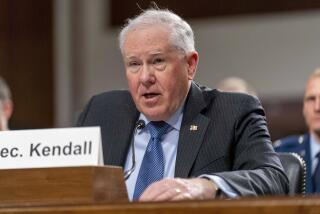Defense Worker Loses Job Over His Ties to India : Aerospace: TRW and Northrop defend engineer on B-2, who was denied clearance because two sisters live in Madras.
- Share via
Two women in their 60s who grow cotton in Madras, India, apparently pose the newest security threat to the B-2 Stealth bomber program: Their brother was thrown off the B-2 program after a security review deemed the women a risk.
Thasamuthu Ramakrishnan, a U.S. citizen for nine years, had worked on the B-2 project since 1991 as a software engineer under an Air Force special-access clearance and had won plaudits from his supervisors.
But when he attempted to transfer his employment from TRW to Northrop, a new security clearance was required and he entered a Kafkaesque struggle with an Air Force security office whose existence is not even public knowledge.
In November, the new clearance was denied, based simply on the fact that Ramakrishnan had immediate family members living in India. The decision left him unemployed. The Air Force said last week that it was looking into the case at The Times’ request, but declined to comment further.
TRW officials have taken on his cause. Last month, TRW’s security officer for the B-2 program, Martha L. Craft, wrote that Ramakrishnan “has never received a violation or infraction for any breach of security regulation or practice. . . . At no time has there been any doubt in my mind that Ramakrishnan’s dedication to the B-2 program has only been to the benefit of the U.S. government.”
Ramakrishnan appealed the decision, but the Air Force said that since Ramakrishnan is no longer formally employed he has no grounds to appeal.
“We cannot even talk to the Air Force,” Ramakrishnan said. “I have nowhere to go.”
Indeed, amid massive aerospace layoffs, Ramakrishnan has few other job prospects if the Air Force blocks his return to Northrop.
Asian-American advocacy groups complain that the Pentagon often questions the loyalty of Asian-Americans without cause and that such distrust has become a career obstacle. The groups argue that not a single case of espionage is known to have involved an Asian-American in recent years.
Half of all new engineering graduates in California are Asian-Americans. They make up 24% of Hughes Aircraft’s engineers and scientists, 20% of TRW’s and about 10.5% of Northrop’s.
“This case defies all logic,” said Sudhir Chadalavada, founder of the Southern California Indian Professional Assn.
Phillip Chen, vice president of the Chinese Engineers and Scientists Assn. of Southern California, added: “I don’t see why having relatives in India would pose a threat to this country. I think it is groundless. This guy is caught in some kind of bureaucratic quagmire.”
Few Asian-Americans protest, however. Ramakrishnan said his biggest concern about raising his problem publicly was that he might be considered a rabble-rouser by Northrop, which he called “a fine corporation.”
The government’s basis for denying clearances to defense industry workers who have foreign relatives is shrouded in secrecy. The Pentagon has a list of “designated countries” unfriendly to U.S. interests, but an agency spokesman declined to identify them.
About 30 nations are included on the list, such as North Korea, Vietnam and China, but not India, according to defense industry security manuals.
Ramakrishnan said he disclosed the information about his two sisters during the 1989 security investigation. Jaak Treiman, Ramakrishnan’s attorney, said the Air Force said the original clearance should never have been granted.
“This is as bad a case of government double talk as I have seen in a long time,” Treiman said.
Ramakrishnan began working at TRW’s Redondo Beach facility in March, 1980. By 1987, TRW had too many engineers and put Ramakrishnan on an “industry assist program,” in which he was loaned to other aerospace firms.
He worked for two years on the McDonnell Douglas C-17 project in Long Beach, where his work was cited as “instrumental” in developing the aircraft’s computer system, according to a McDonnell letter.
TRW then loaned him to Northrop for the B-2 bomber project in 1989. He was granted special-access clearance from the Air Force through TRW.
By 1991, Northrop began to phase out loaner engineers, though it wanted to keep Ramakrishnan. His supervisor wrote that Ramakrishnan was “uniquely qualified to fill our critical need” on the B-2’s cockpit software system. The Air Force, however, blocked Northrop from formally hiring him.
Treiman, the attorney, said it could take years to sue the Air Force to reverse the decision.
“It doesn’t matter if it was arbitrary or capricious, because courts are not likely to get involved in national security issues,” he said.
More to Read
Inside the business of entertainment
The Wide Shot brings you news, analysis and insights on everything from streaming wars to production — and what it all means for the future.
You may occasionally receive promotional content from the Los Angeles Times.











